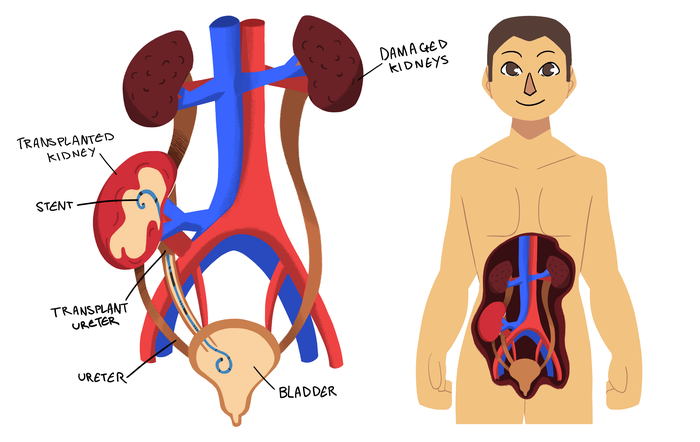Having a stent put in place during your operation is a common part of transplant surgery. While not painful, having the stent removed six weeks later can be a little uncomfortable.
Written by Sam Turner, Consultant Transplant Surgeon, North Bristol NHS Trust
During your kidney transplant procedure, a stent will be placed within the transplant ureter (the tube connecting the kidney to the bladder).
The stent is a thin plastic tube with a curly ‘pigtail’ at either end to keep it in place. One end sits in the transplant kidney, the other end in the bladder, with the longer segment of the tube sitting in the transplant ureter.
The stent prevents urine leaks and narrowing of the ureter in the early period following the transplant. If the stent is left in for too long, it has a higher chance of causing an infection in the urine.
The stent removal procedure

Around four to six weeks after the transplant, you will be invited to the hospital to have the stent removed.
This procedure is usually performed in the hospital outpatients department by either a clinical nurse specialist or doctor with an assistant. You will stay awake, as the whole procedure is only seconds to minutes long and there is no need for a general anaesthetic.
In a private room, you will be asked to lie on a trolley. Your external genitalia will be cleaned with some cold antiseptic fluid and anaesthetic jelly will be applied. This can be uncomfortable and make your toes curl for a few seconds, but it helps to numb and lubricate the area. This numbness can last a few hours.
A camera attached to a thin black tube, called a cystoscope, will then be inserted through your urethra (the tube that carries urine) into the bladder. Again, this can be uncomfortable. The urethra is longer in males, so it takes a little more navigating than in females, but the procedure is otherwise identical in both sexes.
The bladder is partly filled with water, which can give you the urge to pass urine. Using the camera, the operator will then search for the end of the stent that is in your bladder. A tiny ‘grasper’ will be passed down the cystoscope and used to catch hold of the stent.
The stent, grasper and scope are then all pulled out together, which can once again be uncomfortable for a few seconds. The entire procedure normally takes between 30 seconds and two minutes.
After the procedure
Afterwards you will probably feel the urge to pass urine. If it is particularly urgent, please ask for a bottle or bedpan, otherwise you will be directed to a nearby toilet. The urine will look dilute and sometimes slightly blood-stained. Don’t worry if this is the case.
Occasionally, the operator will have difficulty and be unable to remove the stent in this way. If this is the case, you may need to be referred to a urologist. If you have congenital differences involving your genitalia or bladder or have had previous surgery, it may not be possible to remove the stent in the manner described above, and your transplant team will discuss this with you prior to and following your transplant.
NOTE: This article was first published in May 2021 in Issue 13 of our Kidney Matters magazine.
